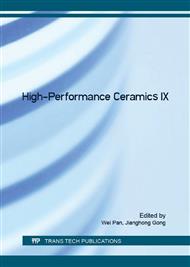[1]
S. Nakamura, T. Mukai, M. Senoh, Candela-class high-brightness InGaN/AlGaN double-hetero- structure blue-light-emitting diodes, Appl. Phys. Lett. 64 (1994) 1687-1689.
DOI: 10.1063/1.111832
Google Scholar
[2]
E. F. Schubert, J. K. Kim, Solid-state light sources getting smart, Science 308 (2005) 1274-1278.
DOI: 10.1126/science.1108712
Google Scholar
[3]
R. J. Xie, N. Hirosaki, M. Mitomo, et al., Wavelength-tunable and thermally stable Li-α-sialon: Eu2+ oxynitride phosphors for white light-emitting diodes, Appl. Phys. Lett. 89 (2006) 241103-3.
DOI: 10.1063/1.2402880
Google Scholar
[4]
D.A. Steigerwald, J.C. Bhat, D. Collins, et al., Illumination With Solid State Lighting Technology, IEEE J. Sel. Top. Quantum Electron. 8 (2002) 310-320.
DOI: 10.1109/2944.999186
Google Scholar
[5]
S. Muthu, F. J. P. Schuurmans, M. D. Red, Green, and Blue LEDs for White Light Illumination, IEEE J. Sel. Top. Quantum Electron. 8 (2002) 333-338.
DOI: 10.1109/2944.999188
Google Scholar
[6]
Y. Chen, M. Gong, G. Wang, Q. Su, High efficient and low color-temperature white light-emitting diodes with Tb3Al5O12: Ce3+ phosphor, Appl. Phys. Lett. 91 (2007) 071117-3.
DOI: 10.1063/1.2771538
Google Scholar
[7]
H.S. Jang, W.B. Im, D.C. Lee, et al., Enhancement of red spectral emission intensity of Y3Al5O12: Ce3+ phosphor via Pr co-doping and Tb substitution for the application to white LEDs, Lumin. 126 (2007) 371-377.
DOI: 10.1016/j.jlumin.2006.08.093
Google Scholar
[8]
J. Kido, H. Shionoya, K. Nagai, Single-layer white light-emitting organic electroluminescent devices based on dyedispersed poly(N-vinylcarbazole), Appl. Phys. Lett. 67 (1995) 2281-2283.
DOI: 10.1063/1.115126
Google Scholar
[9]
R.C. Evans, L.D. Carlos, P. Douglas, et al., Tuning the emission colour in mixed lanthanide micro- porous silicates: energy transfer, composition and chromaticity, Mater. Chem. 18 (2008) 1100-1107.
DOI: 10.1039/b715675h
Google Scholar
[10]
L.F. Hu, R.Z. Ma, T.C. Ozawa, T. Sasaki, Oriented Monolayer Film of Gd2O3: 0. 05Eu Crystallites: Quasi-Topotactic Transformation of the Hydroxide Film and Drastic Enhancement of Photoluminescence Properties, Angew. Chem. Int. Ed. 48 (2009) 3846.
DOI: 10.1002/anie.200806206
Google Scholar
[11]
Y.Q. Liu, X.P. Zhang, Y. N. Xia, H. Yang, Magnetic-Field-Assisted Electrospinning of Aligned Straight and Wavy Polymeric Nanofibers, Adv. Mater. 22 (2010) 2454-2457.
DOI: 10.1002/adma.200903870
Google Scholar
[12]
H. Wu, Y. Sun, D. D. Lin, et al., GaN Nanofibers based on electrospinning: facile synthesis, controlled assembly, precise doping, and application as high performance UV photodetector, Adv. Mater. 21 (2009) 227-231.
DOI: 10.1002/adma.200800529
Google Scholar
[13]
S. Agarwal, A.J. Greiner, H. Wendorff, Electrospinning of manmade and biopolymer nanofibers- progress in techniques, materials, and applications, Adv. Funct. Mater. 19 (2009) 2863-2879.
DOI: 10.1002/adfm.200900591
Google Scholar
[14]
A. Greiner, J. H. Wendorff, Electrospinning: A Fascinating Method for the Preparation of Ultrathin Fibers, Angew. Chem. Int. Ed. 46 (2007) 5670-5703.
DOI: 10.1002/anie.200604646
Google Scholar
[15]
H.W. Song, H.Q. Yu, G.H. Pan, et al., Electrospinning preparation, structure, and photoluminescence properties of YBO3: Eu3+ nanotubes and nanowires, Chem. Mater. 20 (2008) 4762-4767.
DOI: 10.1021/cm8007864
Google Scholar
[16]
Z.Y. Hou, C.X. Li, et al., One-dimensional CaWO4 and CaWO4: Tb3+ nanowires and nanotubes: electrospinning preparation and luminescent properties, J. Mater. Chem. 19 (2009) 2737-2746.
DOI: 10.1039/b818810f
Google Scholar
[17]
Y.X. Gu, Q.H. Zhang, et al., CaSi2O2N2: Eu nanofiber mat based on electrospinning: facile synthesis, uniform arrangement, and application in white LEDs, J. Mater. Chem. 21 (2011) 17790-17797.
DOI: 10.1039/c1jm13351a
Google Scholar
[18]
C.H. Huang, T.S. Chan, W.R. Liu, et al., Crystal structure of blue–white–yellow color-tunable Ca4Si2O7F2: Eu2+, Mn2+ phosphor and investigation of color tunability through energy transfer for single-phase white-light near-ultraviolet LEDs, J. Mater. Chem. 22 (2012).
DOI: 10.1039/c2jm33160h
Google Scholar


